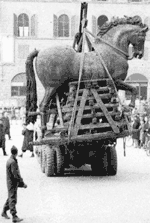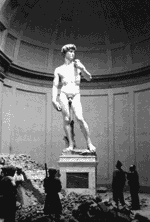| |
Comment on this article Collateral Damage
As a “fine arts officer” in World War II, Yale art professor Deane Keller helped to rescue Italian masterworks from the ravages of war. His efforts are documented in a remarkable collection of photographs in Sterling Memorial Library.
March 2003
by Catherine Roach ’02 Catherine Roach catalogued the Deane Keller Papers while working for Manuscripts and Archives as an undergraduate. The collection was a source for her senior essay in the history of art, which focused on art theft during World War II. When the Allies invaded Italy in the summer of 1943, Yale art professor Deane Keller ’23 was among the troops scrambling ashore in Naples. In civilian life, Keller taught painting and created portraits of Yale worthies that adorn dining halls to this day. As a young artist fresh from the Yale School of Fine Arts, Keller won the prestigious Prix de Rome, an award that sent him to study in Italy between 1923 and 1926. But 20 years later, he landed in Italy on a different mission. The artworks that Keller had emulated as a student suddenly became his to preserve. As a fine arts officer assigned to the U.S. Fifth Army, Keller was responsible for protecting Italian cultural treasures against the threats of combat and looting. Over the next three years, Keller would encounter everything from endangered Roman ruins to purloined Renaissance altarpieces. In places like Pisa, Keller and his fellow arts officers struggled to salvage shattered medieval frescoes. After the liberation of Florence, they were greeted by empty museums. The city, famed as the cradle of the Renaissance, had been a contested site in the war, and many of the artworks that had made Florence famous were missing. Works by artists such as Botticelli and Duccio that had been removed from the city to protect them from bombing were later seized as spoils of war by retreating German forces. When the looted artworks were discovered piled haphazardly in a carriage house near the Austrian border, Keller was in charge of seeing them safely back to Florence. The photographs on these pages record some of the most dramatic moments in Keller’s efforts on the cultural front of the war. Keller and his friend Charles Bernholz were authorized to take pictures of their duties, a commission that resulted in a remarkable collection of some 12,000 images depicting heroic restorations as well as terrible damage. After his death, Deane Keller’s widow, Katherine H. Keller, donated his papers and photographs to Yale. Now in the collection of the Manuscripts and Archives department at Sterling Memorial Library, these records will provide a resource for years to come. By depicting familiar masterpieces in perilous situations, they challenge us to rethink our concept of the eternal artwork, untouched and outside of time. Instead they show us that works of art are human creations, and as such are subject to human conflict and human intervention. The photographs seen here testify to one Yale professor’s efforts to salvage these creations in the midst of war.
 |
Deane Keller had studied Italian art on a Rome Prize fellowship in the 1920s. The war brought him back to Italy to protect the country’s art, a task that included the rescue of masterpieces looted from the Uffizi Gallery in Florence. |
 |
The great bronze statue of Cosimo de Medici by Giambologna was hidden outside Florence during the war. Keller oversaw its return to the main square, which U.S. Army officials hoped would boost the city’s morale. |
 |
Keller rests his hand on the forehead of the statue of Cosimo de Medici and contemplates the statue before its return to Florence. |
 |
Resembling a modern-day Trojan horse, the equestrian portion of the Cosimo de Medici statue is wheeled though the plaza as Florentine citizens look on. Restoring the massive statue was a huge undertaking requiring engineers as well as art experts. |
 |
Workers gaze at Michelangelo’s David, which has just been freed of protective masonry coverings designed to protect it from bombing. |
|
|






